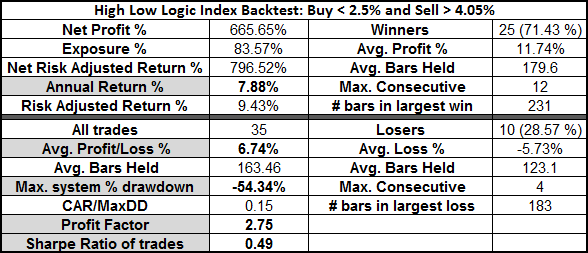The Miner 49er sent me a link to this article from MarketWatch:
CHAPEL HILL, N.C. (MarketWatch) — Would you be interested in a market indicator that has correctly called every major market top and bottom in recent decades—with few false signals?
Of course you would.
And the good news doesn’t stop there: This exceptional indicator is currently in very bullish territory.
The indicator I’m referring to is the High Low Logic Index, which was devised in the 1970s by Norman Fosback, then the President of the Institute for Econometric Research, and currently editor of Fosbacks Fund Forecaster. The index represents the lesser of two numbers: New 52-week highs and new 52-week lows with both expressed as a percentage of total issues traded.
Higher readings of the High Low Logic Index are bearish, according to Fosback, as they suggest that “the market is undergoing a period of extreme divergence… Such divergence is not usually conducive to future rising stock prices, [since] a healthy market requires some semblance of internal uniformity.”
Interestingly, Fosback found from his research, “it doesn’t matter what direction that uniformity takes. Many new highs and very few lows is obviously bullish, but so is a great many new lows accompanied by few or no new highs.”
Fosback in the 1970s recommended a 10-week exponential moving average of the indicator, and this is the approach taken by Ned Davis Research. The firm each weekend updates a version of the index based on all publicly-traded stocks in the U.S. Its latest value is 1.7%, which is solidly in bullish territory.
In fact, there have been only four other occasions over the last 25 years in which the Ned Davis Research version of the High Low Logic Index has moved from bearish territory above 4.05% to as low as it is today, and all four came close to a major market bottom: Late 1987, late 1990, early 2003, and late 2008.
This last occasion represented the most premature the indicator came in anticipating a bull market, and even then it was only 3-4 months early.
The threshold level that Ned Davis Research has used in its back testing to indicate bullish market breadth is 2.5%.
Whenever the 10-week exponential moving average of the High Low Logic Index is below this level, according to the firm, the S&P 500 index (SPX) has appreciated at a 17.9% annualized rate. Whenever it has been above 4.05%, in contrast, the S&P 500 index has declined at a 12.5% annualized pace.
Did this indicator anticipate the market’s weakness in August and September of this year? Unfortunately not, which is another way of saying that the message of the indicator is that recent weakness was not the beginning of a major bear market. The highest it ever got to was 3.2%, according to Ned Davis Research, a level that the firm’s back testing has indicated to be a neutral reading.
The last time the indicator was higher than the 4.05% sell threshold was late 2007, just before the Great Recession and associated credit crunch.
The bulls can only hope that the indicator will be as successful this time around as it was on prior occasions.
The indicator sounds pretty cool, so I decided to code it and put it through the paces.
Let’s take a look at what I’ve come up with.

The chart above is weekly chart of $SPX, with the High Low Logic Index (HLLI) beneath it. The MarketWatch article was published on 10.18.11, and it references a HLLI reading of 1.7%. Note that last week’s HLLI EMA was 1.71%. Because these reading match, I feel fairly certain I have accurately constructed the index.
I had originally used de-listed, survivor-free data, but doing so generates reading that do not match the article reference. Since the chart above used only major exchange listed stocks to create the metric, I assume that Ned Davis Research is not using survivor-free data. In future posts on this indicator, I will be using survivor-free data. Since we want to backtest this indicator going back more than 20 years, it will be important that the data be survivor-free.
Let’s Backtest It…
Buy/Sell Rules:
Buy $SPX at the Close if the HLLI is < 2.5%
Sell $SPX at the Close if the HLLI is > 2.5%
No commissions or slippage included. Data used was NOT survivor-free. First trade was 1.2.1985
Results:

The article also states that bearish territory is above 4.05%. Let’s use this level and make a modification:
Buy $SPX at the Close if the HLLI is < 2.5%
Sell $SPX at the Close if the HLLI is > 4.05%
We are now waiting for the bearish threshold to sell, rather than selling as soon as the indicator leaves bullish territory.
Results:

While selling above 4.05% does not significantly affect the annual return, it does significantly lower risk-adjusted returns. The maximum drawdown is also worse, as is the Sharpe Ratio.
On the other hand, staying long beneath 2.5% and in cash above means making almost 5 times as many trades. Commissions will seriously affect these returns.
Buying and holding $SPX over the same time yields an annual return of 7.74% with a maximum drawdown of -56.73%. The first model has a smaller drawdown, but with both models, once commissions are included, they will likely not have beaten buy-and-hold.
These initial tests are not all that impressive, but I do think the indicator is interesting and is worth exploring further. Over the next few days, I will adjust the indicator to use daily bars (rather than weekly) and will test it using various thresholds over survivor-free data. Finally, I have a tweak in mind which I believe may improve results.
Bonus: Below is the equity curve for the Long <2.5% model.

Comments »














